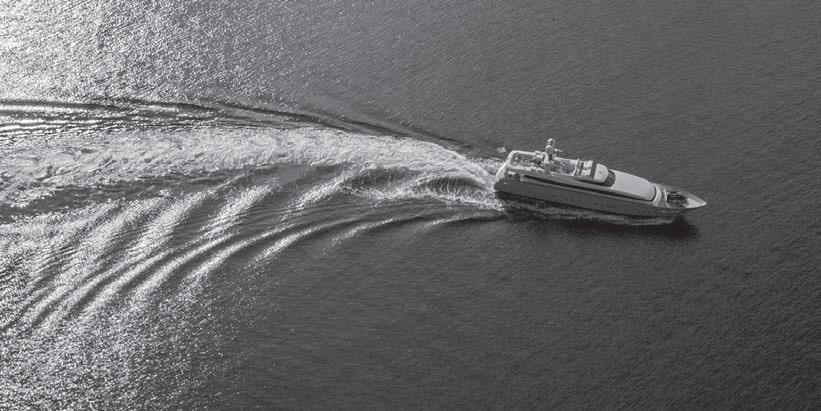
3 minute read
Where are we headed in 2023?
In 2022, two statements stood out for me that highlight the attitude towards climate change and the future of yachting: ‘But superyachts are clean!’ by a CEO of a renowned brokerage and ‘Adapt or die!’ from a CEO of a North European shipyard. There’s still a large gap between those who believe we can continue with ‘business as usual’ (BAU) and those who believe that the environment and climate change represent an existential threat to the superyacht industry.

To provide some context to these conflicting viewpoints, the graph (overleaf) of superyacht emissions based on IMO data and projected growth demonstrates how much work there is to do with a BAU pathway.
As the industry likes to position itself and its client base at the forefront of maritime technology, should we not be showing leadership and setting a target of approximately 45 per cent reduction in CO2 by 2030 compared to 2012 (the earliest available data from the IMO) to align with the Paris Agreement?
The IMO target is based on a 40 per cent reduction in ‘carbon intensity’ or
‘work’, something that is proving difficult to define for yachts, so a net reduction in emissions is a better choice and more easily measured – if only we had the data!
Interestingly, up until 2021, the total CO2 emissions from shipping were relatively flat. Our steeper slope is because, unlike shipping with a replacement cycle of about 20 years, our fleet continues to age and grow year-on-year, with very few yachts going for scrap. Also, the regulations driving efficiency gains and CO2 reductions in shipping are not yet applicable to yachts.
This year-on-year growth and lack of measurable efficiency gains mean we have a much harder job of reducing overall emissions. To compensate for growth, ever greater efficiency gains and/or low-carbon fuels would be required just to flatten the slope because as each year passes without action, the more difficult it will become to reach the target.
Of course, the graph is not perfect. For example, the IMO data does not include shore power or automotive gas oil (AGO), and it’s mainly based on automatic identification system data and bunker receipts of marine diesel oil and marine gas oil, so the total emissions may be somewhat underestimated. 2020 and 2021 would also have seen reduced emissions due to Covid, and we don’t know if yachts that have come into the fleet after 2018 are more efficient and, if so, by how much.
Fuel consumption and emissions for commercial shipping are more up to date due to the IMO’s Data Collection Service (DCS – 2019) and the EU’s Mandatory Reporting and Verification (MRV – 2015). Neither of these applies to superyachts due to vessel type and size.

This is where our own ‘verified’ data could help. It would provide us with a baseline and the necessary evidence to prove the industry is taking responsible action and reducing CO2 emissions. Without this data, it would be impossible to counter claims made about the industry.
The same goes for energy-efficiency ratings. The more data we provide to the likes of Water Revolution
Foundation, YETI and The Superyacht ECO Association (SEA) Index, the more accurate and useful their tools will become. There’s no doubt that prospective owners and charterers, as well as lenders and insurers, will be interested in energy-efficiency ratings in the coming years.
Most of the data is already in the hands of captains and management companies. Fleet-wide data could be anonymised to avoid any confidentiality issues. This would help provide a more accurate figure of the industry’s emissions and improvements over time and is crucial to support the industry’s commitment to align with the goals of the IMO and/or the Paris Agreement, surely something that’s well overdue and needs to happen.
While there’s a lot of noise and, dare I say, ‘greenwashing’ around the topic, there’s also a collective silence on any measurable commitments. Where do the major shipyards, brokerage houses, management companies, designers, shipyards and associations such as SYBAss, MYBA and ISS stand on decarbonisation?
It’s not as if we don’t have solutions.
There are already some innovative yachts, both in-build and proposed, that will help prove the alternative solutions, technology and fuels; these will no doubt help to define the future of yachting. There’s also much that can be done today through the smart use of energy via operational changes as well as efficiency gains offered by new systems and technology.
We’re also seeing the more widespread availability of second-generation bio-diesel such as HVO (hydrotreated vegetable oil), suitable for many legacy yachts and yachts in build that still need diesel fuel, and this can make an immediate and significant impact.
Will 2023 be the year the industry finally comes together and acknowledges that ‘business as usual’ is not sustainable and that we must work collectively to ensure the future of yachting? Will we finally see climate goals being set and the use of data from individual yachts and the fleet as evidence that the industry wants to be part of the solution and not part of the problem? MJ













